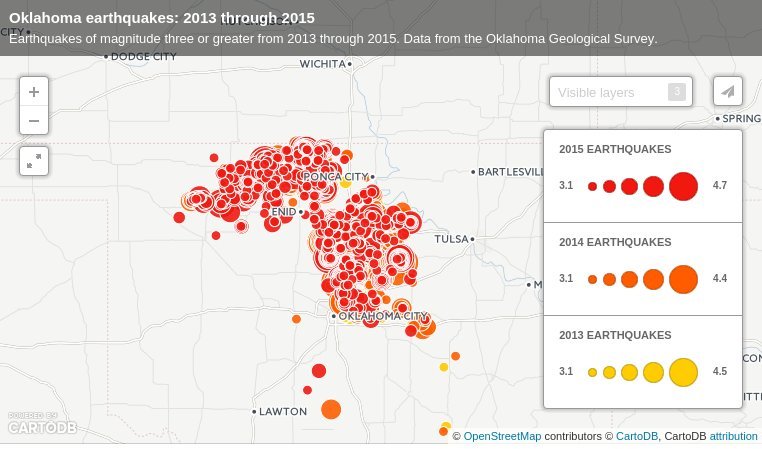While Oklahoma's spike in earthquakes has been heavily publicized, Jeremy Boak, director of the Oklahoma Geological Survey, said it's less widely known that the state has been taking steps toward combating the pattern of induced seismicity.
After a series of earthquakes in Cushing, Oklahoma, the Oklahoma Corporation Commission has issued restrictions on disposal wells: certain wells' operations have been required to reduce their depth — a plug-back restriction — and others have been required to reduce the volume of produced water that they're injecting. Similar plans have been put in place following earthquake activity in the Bedford, Fairview, Byron and Cherokee areas.
"It seems like one of the best kept secrets is that the Corporation Commission is doing all these things," Boak said. "What they're doing has been publicized, but people keep talking about how the state's doing nothing. It's not really true. There are some issues that the state hasn't yet figured out how to address."
The Oklahoma Geological Survey attributes the spike in earthquakes to injection of water into the earth — water that is produced through oil and gas production processes. The OCC acknowledged the OGS's position on the cause of Oklahoma's seismic activity in April, noting in a statement that the survey's findings have helped pave the way for regulating injection processes.
Though a common misconception is that fracking causes earthquakes, Boak explained that only about five percent of the wastewater being injected into the earth is fracking-flowback water. The rest is naturally occurring water that is removed with oil and gas production.
Comment: If we were you, we wouldn't believe that. Sounds a lot like damage control. Ask yourselves, why has quake activity increased so drastically, recently? Well, the significant recently increased activity that might explain this logically is fracking.
Because of the sharp rise in the number of earthquakes in Oklahoma, some outlets have lauded the state "the earthquake capital of the country." However, Boak says that's not entirely accurate.
"There are people out there saying that we're now the earthquake capital of the U.S., but it sort of depends on what matters to you," Boak said. "If you look at the total number of earthquakes of magnitude three or greater, there's more in Oklahoma than in California."
Looking at earthquakes of magnitude four or greater, Oklahoma still has more than California, Boak said. But looking at earthquakes of magnitude five or greater since 2013, California has Oklahoma beat — California's largest has been a 5.7, and Oklahoma hasn't recorded any of magnitude five in that time period.
"It sort of comes down to whether you like your shaking regular and modest or less frequent and big," Boak said. "It's hard to decide what the capital is."
As the commission implements restrictions on injection wells, it will take time before the data will show whether the regulations are decreasing the number of earthquakes.
"It takes some time until you really start seeing some response in the earthquakes, so the pulse that happened in November is largely going on up in that northern part of the state, and they've just begun to take actions that might slow it down," Boak said.
Restrictions are probably an "appropriate reaction" to the rise in earthquakes, Boak said.
"It's challenging to know exactly the perfect reaction. We're still learning a huge amount about this, and science unfortunately can't move as quickly as the news cycle," Boak said. "We're a little unsure what might be the absolute best thing to do, but I think that putting some restrictions on the wells that are near the earthquakes is probably a good thing to do.




Comment: Putting "some" restriction? Again this Boak person sounds like he's doing damage control on behalf of unspecified interests in the oil and gas industry.